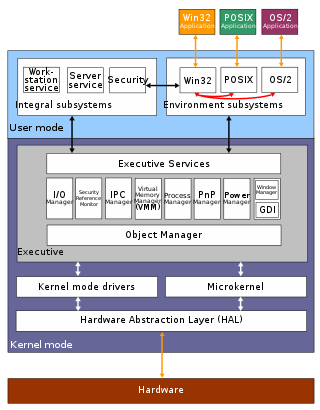Related Research Articles

GNU Hurd is a collection of microkernel servers written as part of GNU, for the GNU Mach microkernel. It has been under development since 1990 by the GNU Project of the Free Software Foundation, designed as a replacement for the Unix kernel, and released as free software under the GNU General Public License. When the Linux kernel proved to be a viable solution, development of GNU Hurd slowed, at times alternating between stasis and renewed activity and interest.

In computer science, a microkernel is the near-minimum amount of software that can provide the mechanisms needed to implement an operating system (OS). These mechanisms include low-level address space management, thread management, and inter-process communication (IPC).
Mach is a kernel developed at Carnegie Mellon University by Richard Rashid and Avie Tevanian to support operating system research, primarily distributed and parallel computing. Mach is often considered one of the earliest examples of a microkernel. However, not all versions of Mach are microkernels. Mach's derivatives are the basis of the operating system kernel in GNU Hurd and of Apple's XNU kernel used in macOS, iOS, iPadOS, tvOS, and watchOS.

An operating system (OS) is system software that manages computer hardware and software resources, and provides common services for computer programs.

In computer science, a thread of execution is the smallest sequence of programmed instructions that can be managed independently by a scheduler, which is typically a part of the operating system. The implementation of threads and processes differs between operating systems. In Modern Operating Systems, Tanenbaum shows that many distinct models of process organization are possible. In many cases, a thread is a component of a process. The multiple threads of a given process may be executed concurrently, sharing resources such as memory, while different processes do not share these resources. In particular, the threads of a process share its executable code and the values of its dynamically allocated variables and non-thread-local global variables at any given time.
OpenStep is a defunct object-oriented application programming interface (API) specification for a legacy object-oriented operating system, with the basic goal of offering a NeXTSTEP-like environment on non-NeXTSTEP operating systems. OpenStep was principally developed by NeXT with Sun Microsystems, to allow advanced application development on Sun's operating systems, specifically Solaris. NeXT produced a version of OpenStep for its own Mach-based Unix, stylized as OPENSTEP, as well as a version for Windows NT. The software libraries that shipped with OPENSTEP are a superset of the original OpenStep specification, including many features from the original NeXTSTEP.

QNX is a commercial Unix-like real-time operating system, aimed primarily at the embedded systems market. QNX was one of the first commercially successful microkernel operating systems.

In computer science, inter-process communication or interprocess communication (IPC) refers specifically to the mechanisms an operating system provides to allow the processes to manage shared data. Typically, applications can use IPC, categorized as clients and servers, where the client requests data and the server responds to client requests. Many applications are both clients and servers, as commonly seen in distributed computing.

XNU is the computer operating system (OS) kernel developed at Apple Inc. since December 1996 for use in the Mac OS X operating system and released as free and open-source software as part of the Darwin OS, which in addition to macOS is also the basis for the Apple TV Software, iOS, iPadOS, watchOS, and tvOS OSes. XNU is an abbreviation of X is Not Unix.
Accent is an operating system kernel, most notable for being the predecessor to the Mach kernel. Originally developed at Carnegie Mellon University (CMU), Accent was influenced by the Aleph kernel developed at the University of Rochester. Accent improves upon the older kernel, fixing several problems and re-targeting hardware support for networks of workstation machines instead of minicomputers. Accent was part of the SPICE Project at CMU which ran from 1981 to 1985. Development of Accent led directly to the introduction of Mach, used in NeXTSTEP, GNU Hurd, and modern Apple operating systems including Mac OS and iOS.
Spring is a discontinued project in building an experimental microkernel-based object-oriented operating system (OS) developed at Sun Microsystems in the early 1990s. Using technology substantially similar to concepts developed in the Mach kernel, Spring concentrated on providing a richer programming environment supporting multiple inheritance and other features. Spring was also more cleanly separated from the operating systems it would host, divorcing it from its Unix roots and even allowing several OSes to be run at the same time. Development faded out in the mid-1990s, but several ideas and some code from the project was later re-used in the Java programming language libraries and the Solaris operating system.

The architecture of Windows NT, a line of operating systems produced and sold by Microsoft, is a layered design that consists of two main components, user mode and kernel mode. It is a preemptive, reentrant multitasking operating system, which has been designed to work with uniprocessor and symmetrical multiprocessor (SMP)-based computers. To process input/output (I/O) requests, they use packet-driven I/O, which utilizes I/O request packets (IRPs) and asynchronous I/O. Starting with Windows XP, Microsoft began making 64-bit versions of Windows available; before this, there were only 32-bit versions of these operating systems.
Vanguard is a discontinued experimental microkernel developed at Apple Computer, in the research-oriented Apple Advanced Technology Group (ATG) in the early 1990s. Based on the V-System, Vanguard introduced standardized object identifiers and a unique message chaining system for improved performance. Vanguard was not used in any of Apple's commercial products. Development ended in 1993 when Ross Finlayson, the project's main investigator, left Apple.
The RC 4000 Multiprogramming System is a discontinued operating system developed for the RC 4000 minicomputer in 1969. For clarity, this article mostly uses the term Monitor.
TRIX is a network-oriented research operating system developed in the late 1970s at MIT's Laboratory for Computer Science (LCS) by Professor Steve Ward and his research group. It ran on the NuMachine and had remote procedure call functionality built into its kernel, but was otherwise a Version 7 Unix workalike.
A network socket is a software structure within a network node of a computer network that serves as an endpoint for sending and receiving data across the network. The structure and properties of a socket are defined by an application programming interface (API) for the networking architecture. Sockets are created only during the lifetime of a process of an application running in the node.

Minix 3 is a small, Unix-like operating system. It is published under a BSD-3-Clause license and is a successor project to the earlier versions, Minix 1 and 2.
A process is a program in execution, and an integral part of any modern-day operating system (OS). The OS must allocate resources to processes, enable processes to share and exchange information, protect the resources of each process from other processes and enable synchronization among processes. To meet these requirements, the OS must maintain a data structure for each process, which describes the state and resource ownership of that process, and which enables the OS to exert control over each process.

The kernel is a computer program at the core of a computer's operating system and generally has complete control over everything in the system. It is the portion of the operating system code that is always resident in memory and facilitates interactions between hardware and software components. A full kernel controls all hardware resources via device drivers, arbitrates conflicts between processes concerning such resources, and optimizes the utilization of common resources e.g. CPU & cache usage, file systems, and network sockets. On most systems, the kernel is one of the first programs loaded on startup. It handles the rest of startup as well as memory, peripherals, and input/output (I/O) requests from software, translating them into data-processing instructions for the central processing unit.
Thoth is a real-time, message passing operating system (OS) developed at the University of Waterloo in Waterloo, Ontario Canada.
References
Rashid, Richard F (1986). "From RIG to Accent to Mach: the evolution of a network operating system". Proceedings of 1986 ACM Fall joint computer conference. pp. 1128–1137. ISBN 0-8186-4743-4. S2CID 1114881.